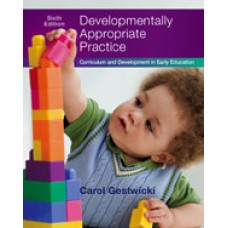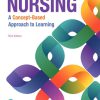Test Bank for Developmentally Appropriate Practice Curriculum and Development in Early Education, 6th Edition
$35.00 Original price was: $35.00.$26.50Current price is: $26.50.
Test Bank for Developmentally Appropriate Practice Curriculum and Development in Early Education, 6th Edition
This is completed downloadable of Test Bank for Developmentally Appropriate Practice Curriculum and Development in Early Education, 6th Edition

Product Details:
- ISBN-10 : 9781305501027
- ISBN-13 : 978-1305501027
- Author: Carol Gestwicki
Thoughtful and comprehensive, DEVELOPMENTALLY APPROPRIATE PRACTICE: CURRICULUM AND DEVELOPMENT IN EARLY EDUCATION, 6th Edition, is designed to meet the needs of new early childhood students as well as experienced teachers, professionals, and parents. It provides you with an overview of the concepts and theoretical foundations of appropriate practices in every developmental domain and discusses the practical implications for teachers and caregivers. The text reflects the NAEYC position statement on Developmentally Appropriate Practice and includes content on aligning early childhood teaching practices with national education standards, in addition to many interesting anecdotes, vignettes, interactive features, and applications to help you understand and apply the material. The text also shows you how to be effective no matter what curriculum model is used in your center, whether Reggio Emilia, Montessori, High Scope, Creative Curriculum, Bank Street, Waldorf, or any other.
Table of Content:
- Section 1: Defining Developmentally Appropriate Practice
- Ch 1: Defining Developmentally Appropriate Practice
- Ch 1: Learning Objectives
- Ch 1: Introduction
- 1-1: What Is the Position Statement on Developmentally Appropriate Practice?
- 1-2: Essential Components of DAP
- 1-3: Basic Principles of Development
- 1-4: Results of Developmentally Appropriate versus Inappropriate Practice
- 1-5: Misunderstandings about Developmentally Appropriate Practice
- Ch 1: Summary
- Ch 1: Think about It Activities
- Ch 1: Questions to Assess Learning of Chapter Objectives
- Ch 1: Apply Your Knowledge: Case Studies
- Ch 1: Helpful Websites
- Ch 2: Understanding Play: Its Importance in Developmentally Appropriate Practice
- Ch 2: Learning Objectives
- Ch 2: Introduction
- 2-1: What Is Play?
- 2-2: Categories of Play
- 2-3: Social Stages of Play
- 2-4: Theories of Play and Development
- 2-5: Play as Developmentally Appropriate Curriculum
- 2-6: Conditions that Support Play
- 2-7: Frequently Asked Questions about Play
- 2-8: Helping Families Understand the Power of Play
- Ch 2: Summary
- Ch 2: Think about It Activities
- Ch 2: Questions to Assess Learning of Chapter Objectives
- Ch 2: Apply Your Knowledge: Case Studies
- Ch 2: Helpful Websites
- Ch 3: Planning for Developmentally Appropriate Curriculum
- Ch 3: Learning Objectives
- Ch 3: Introduction
- 3-1: What Is Curriculum?
- 3-2: Integrated Curriculum
- 3-3: The Cycle of Planning
- 3-4: Advantages and Disadvantages of Theme Planning
- 3-5: Emergent Curriculum and the Project Approach
- 3-6: Strategies for Planning for Emergent Curriculum
- 3-7: What about Planning Forms?
- 3-8: Changing the Planning Process
- Ch 3: Summary
- Ch 3: Think about It Activities
- Ch 3: Questions to Assess Learning of Chapter Objectives
- Ch 3: Apply Your Knowledge: Case Studies
- Ch 3: Helpful Websites
- Ch 4: A Consideration of Various Curriculum Models
- Ch 4: Learning Objectives
- Ch 4: Introduction
- 4-1: The Montessori Approach
- 4-2: The Bank Street Approach
- 4-3: The Waldorf Approach
- 4-4: The Reggio Emilia Approach
- 4-5: HighScope Approach
- 4-6: The Creative Curriculum
- Ch 4: Summary
- Ch 4: Think about It Activities
- Ch 4: Questions to Assess Learning of Chapter Objectives
- Ch 4: Apply Your Knowledge: Case Studies
- Ch 4: Helpful Websites
- Section 2: Developmentally Appropriate Physical Environments
- Ch 5: Developmentally Appropriate Physical Environments: For Infants
- Ch 5: Learning Objectives
- Ch 5: Introduction
- 5-1: The Nature of Babies
- 5-2: What Do Babies Need?
- 5-3: Environments That Support Infant Developmental Needs
- 5-4: Outdoors for Infants
- 5-5: Health and Safety
- 5-6: Materials for Infant rooms
- 5-7: Schedule Considerations for Infants
- 5-8: Inappropriate Physical Environments for Infants
- Ch 5: Summary
- Ch 5: Think about It Activities
- Ch 5: Questions to Assess Learning of Chapter Objectives
- Ch 5: Apply Your Knowledge: Case Studies
- Ch 5: Helpful Websites
- Ch 6: Developmentally Appropriate Physical Environments: For Toddlers
- Ch 6: Learning Objectives
- Ch 6: Introduction
- 6-1: What Are Toddlers Like?
- 6-2: What Do Toddlers Need?
- 6-3: Environments That Support Toddler Developmental Needs
- 6-4: Developmentally Appropriate Toddler Materials
- 6-5: Schedule and Transition Considerations
- 6-6: Inappropriate Physical Environments for Toddlers
- Ch 6: Summary
- Ch 6: Think about It Activities
- Ch 6: Questions to Assess Learning of Chapter Objectives
- Ch 6: Apply Your Knowledge: Case Studies
- Ch 6: Helpful Websites
- Ch 7: Developmentally Appropriate Physical Environments: For Preschoolers
- Ch 7: Learning Objectives
- Ch 7: Introduction
- 7-1: What Are Preschoolers Like?
- 7-2: What Do Preschoolers Need?
- 7-3: Environments That Support Preschooler Developmental Needs
- 7-4: Schedules for Preschoolers
- 7-5: Transitions
- 7-6: Kindergarten Today
- 7-7: Inappropriate Physical Environments for Preschoolers
- Ch 7: Summary
- Ch 7: Think about It Activities
- Ch 7: Questions to Assess Learning of Chapter Objectives
- Ch 7: Apply Your Knowledge: Case Studies
- Ch 7: Helpful Websites
- Ch 8: Developmentally Appropriate Physical Environments: For Primary-Age Children
- Ch 8: Learning Objectives
- Ch 8: Introduction
- 8-1: What Are Primary-Age Children Like?
- 8-2: What Do Primary-Age Children Need?
- 8-3: Environment for a Sense of Industry
- 8-4: Environment for Literacy, Math, and Science
- 8-5: Environment for Relationships
- 8-6: Schedules for Primary-Age Children
- 8-7: After-School Childcare
- 8-8: Inappropriate Environments in Primary Classrooms
- Ch 8: Summary
- Ch 8: Think about It Activities
- Ch 8: Questions to Assess Learning of Chapter Objectives
- Ch 8: Apply Your Knowledge: Case Studies
- Ch 8: Helpful Websites
- Section 3: Developmentally Appropriate Social-Emotional Environments
- Ch 9: Developmentally Appropriate Social-Emotional Environments: For Infants
- Ch 9: Learning Objectives
- Ch 9: Introduction
- 9-1: Social-Emotional Issues in Infancy
- 9-2: Developmentally Appropriate Interaction practices
- Ch 9: Summary
- Ch 9: Think about It Activities
- Ch 9: Questions to Assess Learning of Chapter objectives
- Ch 9: Apply Your Knowledge: Case Studies
- Ch 9: Helpful Websites
- Ch 10: Developmental Appropriate Social-Emotional Environments: For Toddlers
- Ch 10: Learning Objectives
- Ch 10: Introduction
- 10-1: Social-Emotional Issues of Toddlerhood
- 10-2: Developmentally Appropriate Interaction with Toddlers
- 10-3: Appropriate Toddler Guidance
- 10-4: Inappropriate Adult Interactions
- Ch 10: Summary
- Ch 10: Think about It Activities
- Ch 10: Questions to Assess Learning of Chapter Objectives
- Ch 10: Apply Your Knowledge: Case Studies
- Ch 10: Helpful Websites
- Ch 11: Developmentally Appropriate Social-Emotional Environments: For Preschoolers
- Ch 11: Learning Objectives
- Ch 11: Introduction
- 11-1: Social-Emotional Issues of the Preschool Years
- 11-2: Developmentally Appropriate Environments for Feelings
- 11-3: Nurturing Individual Identity
- 11-4: Gender Identity
- 11-5: Cultural and Racial Identity
- 11-6: Friendship
- 11-7: Teaching Prosocial Behavior
- 11-8: Guidance toward Self-Control
- Ch 11: Summary
- Ch 11: Think about It Activities
- Ch 11: Questions to Assess Learning of Chapter Objectives
- Ch 11: Apply Your Knowledge: Case Studies
- Ch 11: Helpful Websites
- Ch 12: Developmentally Appropriate Social-Emotional Environments: For Primary-Age Children
- Ch 12: Learning Objectives
- Ch 12: Introduction
- 12-1: Social-Emotional Issues for the Primary Years
- 12-2: Planning Environments to Foster Peer relations
- 12-3: Teacher Strategies to Enhance Self-Esteem
- 12-4: Games with rules and Competition versus Cooperation in Developmentally Appropriate Classrooms
- 12-5: Mixed-Age Groupings
- 12-6: Helping Primary-Age Children with Moral Development
- 12-7: Helping Primary-Age Children with Emotional Growth
- Ch 12: Summary
- Ch 12: Think about It Activities
- Ch 12: Questions to Assess Learning of Chapter Objectives
- Ch 12: Apply Your Knowledge: Case Studies
- Ch 12: Helpful Websites
- Section 4: Developmentally Appropriate Learning Environments
- Ch 13: Developmentally Appropriate Learning Environments: For Infants
- Ch 13: Learning Objectives
- Ch 13: Introduction
- 13-1: Understanding the Nature of Infant Learning
- 13-2: Understanding Sensorimotor Intelligence
- 13-3: Language Development
- 13-4: Principles of Sensorimotor Development
- 13-5: Materials Appropriate at Various Stages of Infancy
- 13-6: Developmentally Appropriate Strategies for Adults Facilitating Cognitive Growth in Infants
- 13-7: Nurturing Language Development
- 13-8: Inappropriate Practices Related to Cognitive/Language Development
- Ch 13: Summary
- Ch 13: Think about It Activities
- Ch 13: Questions to Assess Learning of Chapter Objectives
- Ch 13: Apply Your Knowledge: Case Studies
- Ch 13: Helpful Websites
- Ch 14: Developmentally Appropriate Learning Environments: For Toddlers
- Ch 14: Learning Objectives
- Ch 14: Introduction
- 14-1: Understanding Toddler Cognitive Development
- 14-2: Toddler Language Development
- 14-3: Developmentally Appropriate Learning Environments
- 14-4: Principles for Teaching Toddlers
- 14-5: Planning Curriculum for Toddlers
- 14-6: Materials and Activities for Toddler Learning
- 14-7: Principles for Teaching Language to Toddlers
- 14-8: Unsupportive Cognitive/Language Environments
- Ch 14: Summary
- Ch 14: Think about It Activities
- Ch 14: Questions to Assess Learning of Chapter Objectives
- Ch 14: Apply Your Knowledge: Case Studies
- Ch 14: Helpful Websites
- Ch 15: Developmentally Appropriate Learning Environments: For Preschoolers
- Ch 15: Learning Objectives
- Ch 15: Introduction
- 15-1: Preoperational Thinking
- 15-2: Teachers’ Roles in Supporting Learning through Play
- 15-3: Language/Literacy Environments
- 15-4: Components of Literacy
- 15-5: Mathematics in Preschool and Kindergarten
- 15-6: Science in the Preschool Classroom
- 15-7: Considering Traditional Learning Activities in the Preschool Classroom
- Ch 15: Summary
- Ch 15: Think about It Activities
- Ch 15: Questions to Assess Learning of Chapter Objectives
- Ch 15: Apply Your Knowledge: Case Studies
- Ch 15: Helpful Websites
- Ch 16: Developmentally Appropriate Learning Environments: For Primary-Age Children
- Ch 16: Learning Objectives
- Ch 16: Introduction
- 16-1: Current Issues Involving Schools
- 16-2: Preoperational and Concrete Operational Thinking and DAP
- 16-3: Curriculum Goals in Primary Education
- 16-4: Components of Integrated Curriculum
- 16-5: Language and Literacy
- 16-6: Writing
- 16-7: Math in Primary Classrooms
- 16-8: Science in Primary Classrooms
- 16-9: Assessment versus Standardized testing
- Ch 16: Summary
- Ch 16: Think about It Activities
- Ch 16: Questions to Assess Learning of Chapter Objectives
- Ch 16: Apply Your Knowledge: Case Studies
- Ch 16: Helpful Websites
- Glossary
- References
- Index
People Also Search:
developmentally appropriate practice curriculum and development in early education
developmentally appropriate practice curriculum and development in early education 6th edition
developmentally appropriate practice curriculum and development in early education 6th edition test bank download pdf
developmentally appropriate practice curriculum and development in early education 6th edition download scribd
Related products
Test Bank
Test Bank for Clinical Immunology and Serology A Laboratory Perspective, 3rd Edition: Stevens











